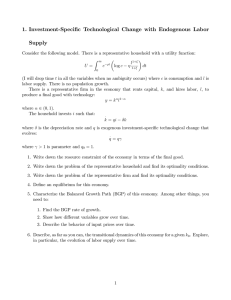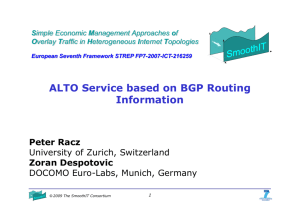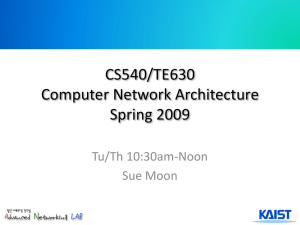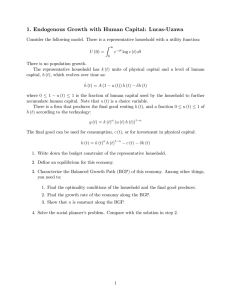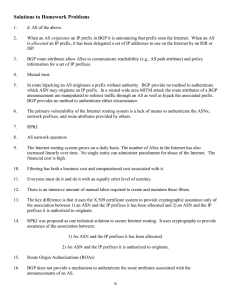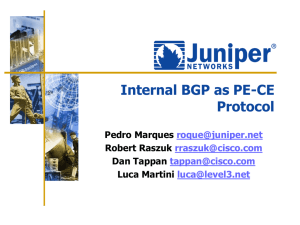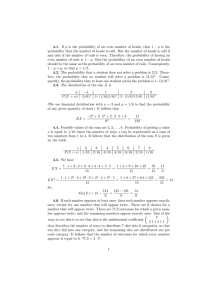Document 13135809
advertisement
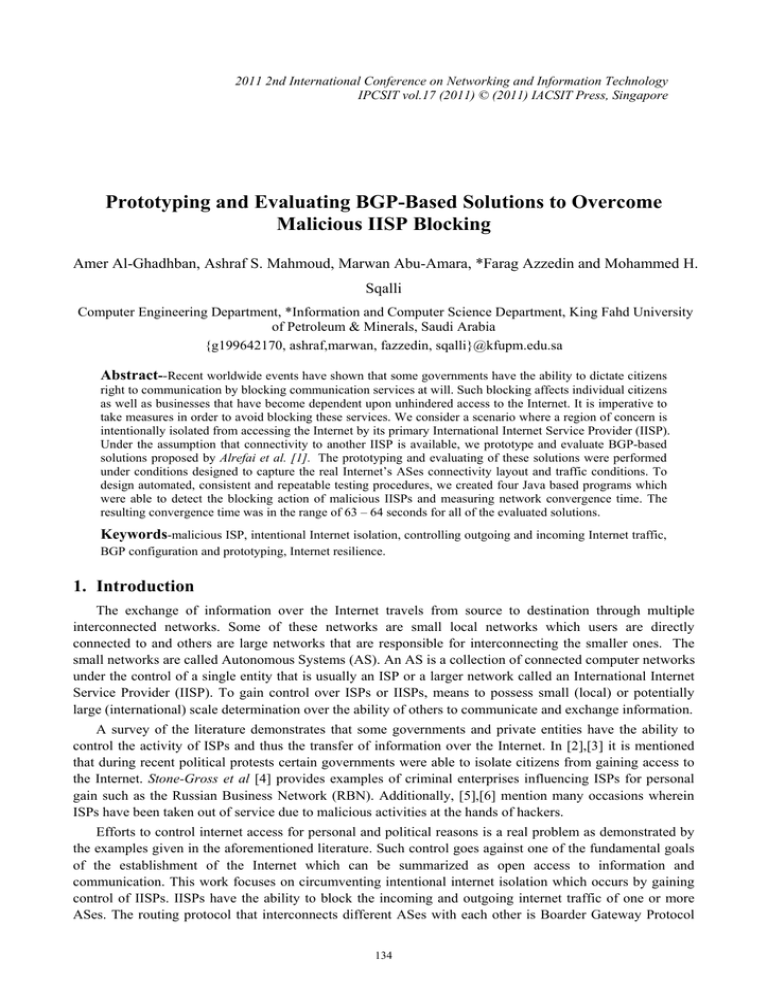
2011 2nd International Conference on Networking and Information Technology
IPCSIT vol.17 (2011) © (2011) IACSIT Press, Singapore
Prototyping and Evaluating BGP-Based Solutions to Overcome
Malicious IISP Blocking
Amer Al-Ghadhban, Ashraf S. Mahmoud, Marwan Abu-Amara, *Farag Azzedin and Mohammed H.
Sqalli
Computer Engineering Department, *Information and Computer Science Department, King Fahd University
of Petroleum & Minerals, Saudi Arabia
{g199642170, ashraf,marwan, fazzedin, sqalli}@kfupm.edu.sa
Abstract--Recent worldwide events have shown that some governments have the ability to dictate citizens
right to communication by blocking communication services at will. Such blocking affects individual citizens
as well as businesses that have become dependent upon unhindered access to the Internet. It is imperative to
take measures in order to avoid blocking these services. We consider a scenario where a region of concern is
intentionally isolated from accessing the Internet by its primary International Internet Service Provider (IISP).
Under the assumption that connectivity to another IISP is available, we prototype and evaluate BGP-based
solutions proposed by Alrefai et al. [1]. The prototyping and evaluating of these solutions were performed
under conditions designed to capture the real Internet’s ASes connectivity layout and traffic conditions. To
design automated, consistent and repeatable testing procedures, we created four Java based programs which
were able to detect the blocking action of malicious IISPs and measuring network convergence time. The
resulting convergence time was in the range of 63 – 64 seconds for all of the evaluated solutions.
Keywords-malicious ISP, intentional Internet isolation, controlling outgoing and incoming Internet traffic,
BGP configuration and prototyping, Internet resilience.
1. Introduction
The exchange of information over the Internet travels from source to destination through multiple
interconnected networks. Some of these networks are small local networks which users are directly
connected to and others are large networks that are responsible for interconnecting the smaller ones. The
small networks are called Autonomous Systems (AS). An AS is a collection of connected computer networks
under the control of a single entity that is usually an ISP or a larger network called an International Internet
Service Provider (IISP). To gain control over ISPs or IISPs, means to possess small (local) or potentially
large (international) scale determination over the ability of others to communicate and exchange information.
A survey of the literature demonstrates that some governments and private entities have the ability to
control the activity of ISPs and thus the transfer of information over the Internet. In [2],[3] it is mentioned
that during recent political protests certain governments were able to isolate citizens from gaining access to
the Internet. Stone-Gross et al [4] provides examples of criminal enterprises influencing ISPs for personal
gain such as the Russian Business Network (RBN). Additionally, [5],[6] mention many occasions wherein
ISPs have been taken out of service due to malicious activities at the hands of hackers.
Efforts to control internet access for personal and political reasons is a real problem as demonstrated by
the examples given in the aforementioned literature. Such control goes against one of the fundamental goals
of the establishment of the Internet which can be summarized as open access to information and
communication. This work focuses on circumventing intentional internet isolation which occurs by gaining
control of IISPs. IISPs have the ability to block the incoming and outgoing internet traffic of one or more
ASes. The routing protocol that interconnects different ASes with each other is Boarder Gateway Protocol
134
(BGP) [7]. While conducting such isolation a malicious IISP creates the appearance that BGP has
successfully identified a functioning path for the transfer of information from source to destination. It
furthermore disguises the fact that the traffic to and from the affected region is actually being blocked.
Whether it is called intentional blocking, intentional isolation or connectivity failure, real solutions must be
identified and implemented in order to protect the Internet and the right to open access thereof.
The main objectives of this work are to prototype and evaluate BGP-based solutions for intentional
internet isolation. The work is characterized by the implementation of these solutions in the laboratory
through a detailed set of experiments. The testing environment and test cases are as close to reality as
possible in their configuration and parameters. Performance figures for the different types of traffic
considered and the representative configurations were collected and compared to identify suitability and
scalability of the proposed solutions. As a condition of validity the testing procedures will be shown to be
consistent in time and repeatable. The evaluated schemes were tested in different scenarios and traffic loads.
Finally, the performance figures, which are included during the blocking were collected for each evaluated
scheme.
2. Literature Review
BGP was designed to provide reliability with minimum overhead. It is not designed with security in
mind, which makes it defenseless to imminent routing attacks. In Hu et al [8] they discuss the security
weaknesses of BGP which are categorized into three main categories. First, BGP does not provide message
integrity and message origin authentication mechanisms and it is vulnerable to a reply attack. Second, BGP
does not provide a mechanism to verify the legality of the AS-Path or prefix advertisements from the AS.
Third, BGP does not verify the validity of BGP attributes included in the BGP advertisements.
BGP attacks have been discussed in Nordstrom and Dovrolis [9] and they name four main purposes for
these attacks as follows: 1. Blackholing 2. Redirection 3. Instability and 4. Supervision. Blackholing is an
attack method of dropping all the traffic bypassing the attacking router. Also, the attacker may drop only
traffic that belongs to a specific AS. Redirection is a method of redirecting all traffic or a specific user’s
traffic to another destination or server for content analysis. Supervision is similar to the previous method, but
the purpose is to modify the traffic content then forward it to the right destination. Instability is an attack
method initiated to harm the network with destablizing events such as injecting false updates, link flapping
or announcing successive advertisement then withdrawals. In this work we are considering the Blackholing
attack method where a malicious IISP isolating a region of concern from the Internet.
In Omer et al [10] a new method and network model are proposed to measure the resilience of the
Internet’s infrastructure by identifying the vulnerabilities of global undersea optical fibers. They evaluate the
effect of the possible losses in these cables against the Internet infrastructure and the recovery from it. Soo
Kim et al. [11] conducted a study which proved that modifying the network topology improves its resilience.
Cohen et al. [12] have shown that scale-free networks like the Internet are susceptible to an intentional attack
because there exists few ASes, e.g. IISPs, which aggregate a large number of the internet connectivity. They
proved mathematically that the removal of one or more of these ASes causes momentous Internet outage.
A more realistic study with practical analysis has been conducted by Dolev et al. [13] wherein they
assume the Internet ASes are connected as a directed graph (policy-based). They made their analysis and
measurements of the resiliency of the Internet based on that assumption. In addition, they concluded that the
Internet is highly sensitive to an intentional attack and could possibly crumble very fast. In contrast, the
Internet is resilient to random failure. A major investigation into the sensitivity of the Internet to a random
fault and attacks was made by Park et al. [14]. They concluded that the Internet is robust and is becoming
more robust with time against random failures; and the average internet diameter is stable even though the
number of internet users is increasing.
3. Problem Statement and BGP-Based Solutions to Be Tested
3.1 Problem Statement
135
Fig.1 Malicious IISP blocking the concerned (considered) region traffic while still exchanging BGP messages.
This study is going to focus on the network configuration depicted in Fig.1 where the region of concern,
denoted by AS100, is connected to the Internet through a primary IISP, defined here as the malicious IISP
and denoted by AS300. The region of concern is also connected through a secondary IISP, called here the
good IISP and specified by AS200. As indicated by its definition the primary IISP for intentional reasons
blocks the incoming and outgoing internet traffic of the region of concern. Although, the malicious IISP
isolates the internet traffic of the region of concern, the malicious IISP’s BGP speaker is still exchanging
keepalive and BGP messages with the concerned region’s BGP speaker and advertising its prefixes on the
internet. However, without these messages being exchanged, the concerned region’s BGP speaker will
directly route the outgoing traffic through the good IISP and acquire incoming traffic through it as well. The
boarder router that carries the traffic between different ASes is called a BGP speaker.
There are two methods to get around Internet connectivity isolation: traffic identity hiding and traffic
control. The former method can be achieved through implementing NATing or tunneling techniques in local
ISP BGP speakers and a cooperative AS in the Internet which are implemented by [15][16]. The latter
method may be accomplished through exploiting the availability of a secondary IISP and employing the BGP
attributes and routing configuration commands to route the outgoing traffic and attract the incoming traffic
through the secondary IISP.
3.2 BGP-Based Solutions To Be Tested
In order to attract the incoming and outgoing traffic out of the primary IISP path a modification to the
BGP path selection procedure of the intermediate routers is needed. The BGP routing protocol has a unique
path selection procedure explained in [7]. The BGP protocol offers configuration commands capable of
controlling the BGP path selection procedure attributes, such as AS-Path Pre-pending and Local-Preference.
Some of the evaluated solutions can influence the incoming traffic to go through the good IISP and others
can control the outgoing traffic. Table.1 shows the classification of the BGP functions based on their ability
in controlling the outgoing traffic or attracting the incoming one.
First of all, the solutions that can influence incoming traffic are AS-Path Shortening, More Specific
Prefixes, and
TABLE.1 THE CLASSIFICATION OF THE BGP METHODS.
Ability
BGP function
AS-Path Shortening
More specific Prefixes
BGP Community
Local Preference
Incoming
Attracter
Yes
Yes
Yes
No
Outgoing
Outforwarder
No
No
No
Yes
BGP Community. In this work these solutions are called Attracters. AS-Path Shortening [1] is implemented
by the region of concern advertising its prefixes using distribute-list configuration commands and the good
IISP originating the concerned region’s prefixes using network commands. As a result, the prefixes appear in
the Internet as belonging to the good IISP and the first AS number in the AS-Path associated with these
prefixes is the good IISP’s AS number (i.e. here is AS200). Hence, the concerned region’s prefixes that are
advertised via the good IISP appear in the Internet with a shorter AS-Path than the ones that advertised via
136
the malicious IISP. In More Specific Prefixes, the routing table algorithm selects the longest prefix match as
a network destination to the forwarding traffic. Based on this, attracting the traffic through the good IISP can
be achieved by advertising long prefixes. However, the accepted length of the prefix on internet routers is
limited to a fixed length [17]. As for BGP Community, the BGP protocol has a community attribute which is
used in the evaluated solutions to influence the incoming traffic going through the good IISP. This attribute
enables any AS to advertise its prefixes associated with a community value to its neighbor ASes. When the
neighboring AS gets the community advertisement it’s going to look at the community value then perform an
action based on it. The action performed here is assigning a higher Local Preference value to the path where
the neighbor gets the community advertisement from. This solution requires cooperation from most of the
ASes between a source and the region of concern. Table 2 shows part of the community values that are used
by Sprint [18], one of the largest IISP in the world. Any subscriber ISP can influence the BGP path selection
procedure of Sprint by associating the appropriate community value with its advertisements. To forward the
region of concern outgoing Internet traffic through the good IISP the Local Preference attribute is used.
The BGP-based solutions are a combination of Attracter with Outforwarder. In [1] they propose only
one solution to control the outgoing traffic because the outgoing traffic is under the control of the region of
concern but the incoming traffic is under control of the source AS and the ASes in between. Table 3
illustrates the BGP-based solutions that were evaluated in this work.
4. Prototype Design and Implementation
The BGP-Based solutions are evaluated in a real laboratory. The laboratory set up contains seven Cisco
2811 routers, four Catalyst 2950 switches, one workstation and three servers. The three servers are set up as
they would be on the Internet side and the workstation as it would be on
TABLE.2 Sprint Local Preference BGP Community Value
BGP Community Value
1239:70
1239:80
1239:90
1239:100
1239:110
Resulting Local Pref
70
80
90
100
110
the local side. Also, each server is assigned to a specific Internet application: FTP, HTTP or VoIP.
Furthermore, one of these servers and the workstation are equipped with WireShark [19] network analyzer to
collect the statistics of each test.
Four Java network programs are also programmed to automate the testing environment. The first and
main software program, called here checker, is capable of checking the Internet connectivity installed in one
of the machines on the local side (AS100). When it faces a sequence of timeout messages, it can immediately
and remotely login to the local side (AS100) BGP speaker and configure it with one of the recommended
BGP-Based solutions. The second software configures the malicious IISP (AS300) BGP speaker with the
Access Control List (ACL) commands to block the outgoing and incoming traffic of the local side (AS100).
The third and fourth software are designed to erase the previous configurations to conduct new testing
attempts.
These four programs are precisely modeled to enhance the manual procedure followed by a network
administrator that relies on human intervention. Whereas the manual procedure provides inaccurate results
and inconsistent movements between steps, the implemented procedures are automated and provide
consistency in time and movement between steps.
4.1 Laboratory Scenarios
The AS-Path length from a local AS to a remote AS through two different IISPs is not always identical.
Based on this fact, the evaluated solutions are examined in two dissimilar laboratory scenarios. The first
scenario, called here identical scenario, is shown in Fig.2 which demonstrates where the AS-Path length
from the local side (AS100) to the Internet side (AS600) over the two IISPs are the same. The second
scenario, called the non identical scenario, is shown in Fig.3 which demonstrates where the AS-Path from the
local side to the Internet side through the good IISP (AS200) is longer than the AS-Path to the same side
137
when it goes through the malicious IISP (AS300). In Fig.2 and 3, AS100 represents the region of concern
and AS600 represents the Internet side where three servers are installed with different Internet applications:
FTP, HTTP and VoIP. Also, the two figures show AS300 as the malicious IISP that is blocking the outgoing
and incoming traffic of the AS100.
TABLE.3 THE BGP-BASED SOLUTIONS
Local Preference
AS-Path Shortening
More specific Prefixes
BGP Community
Fig.2 Identical Scenario
However, AS100 is multihomed to a secondary IISP (good IISP) where the evaluated BGP-solutions
route the outgoing traffic and attract the incoming traffic through it. Routers in the laboratory are configured
to provide the desired connectivity.
Every solution is tested with the same testing procedure. The testing procedure consists of three
dissimilar traffic configurations; the load, being one Internet application, within each configuration is tested
with three different link capacities. Additionally, performance figures for the implemented Internet
applications are measured and analyzed. Performance figures include convergence time, number of lost
packets and end-to-end delay. During the switching, from the malicious IISP to the good IISP, the
performance figures of a current HTTP, FTP or VoIP session are affected. Also, a check is made on whether
or not the BGP-solutions face the same effect. This allows for a comparison of these solutions based on the
effect of switching upon the performance figures. To measure this effect, a network analyzer capable of
measuring the number of lost packets and end-to-end delay of the current session is used in addition to
another program capable of measuring network convergence time.
4.2 Malicious IISP Blocking Configuration
We use ACL to permit the exchange of BGP messages and advertisements between the malicious IISP
and the region of concern BGP speakers and to deny the rest of the traffic. Two ACLs are implemented in
the malicious IISP BGP speaker, one blocking the outgoing traffic and another blocking the incoming traffic.
The first ACL is implemented in the closest interface to the local side (192.0.2.2). The second is
implemented in the interface that is closest to the Internet side (192.0.10.1). Fig.4 shows how the local side
BGP speaker can’t ping to the FTP server after implementing the ACL. Even though the alternative path is
available, the local side BGP speaker still sends the outgoing traffic via the malicious IISP that is dropping it.
The traceroute result also demonstrates that the local BGP speaker still prefers the path via the malicious
IISP (192.0.2.2). After implementing one of the evaluated
138
Fig.3 Non-Identical Scenario
solutions, the local side can ping the Internet side and the traceroute result shows the packets have gone over
the good IISP (192.0.3.2).
4.3 Internet Application Testing Procedure
The Internet applications testing procedure is divided into multiple configurations. In each configuration
a combination of the recommended BGP solutions is tested with one of the following Internet applications:
FTP, HTTP or VoIP. During testing of the configurations, a network analyzer, Wireshark, is used to collect
the required performance figures.
1) Procedure 1
In configuration 1, one of the Internet application’s clients, such as FTP client, residing in the Internet
side (AS100) starts communicating with the compatible server that resides in another Internet side (AS600).
At the same time Wireshark and checker programs are running. At a specified instance in time a program
connects to the malicious IISP router (AS300) and configures it with the blocking configurations. When the
checker faces Internet connectivity loss, it immediately connects to the local side BGP speaker (AS100) and
configures it with one of the BGP solutions, such as Local Preference with AS-Path Shortening.
Configurations 2 and 3 are the same as configuration 1, except using HTTP and VoIP respectively.
2) Procedure 2:
Procedure 2 is identical to procedure 1, but using a different BGP solution.
4.4 Convergence Time Procedure
The time between detecting the malicious action and recovering from it is measured by the software
checker. This time includes, the required time for detecting the action, telnet to the BGP speaker and the
required waiting time for getting the echo-replies from the Internet side’s server. In this work this time is
called convergence time. This procedure is repeated 10 times and the average results are considered.
Over malicious IISP path
C:\Users\marwan>PING 192.0.21.6
Pinging 192.0.21.6 with 32 bytes of data:
Reply from 192.0.2.2: Destination net unreachable.
Reply from 192.0.2.2: Destination net unreachable..
C:\Users\marwan>tracert 192.0.21.6
Tracing route to 192.0.21.6 over a maximum of 30 hops
1 <1 ms <1 ms <1 ms 192.0.1.1
2 192.0.2.2 reports: Destination net unreachable. malicious IISP
Trace complete.
Over alternate path after implementing one of the solutions
C:\Users\marwan>ping 192.0.21.6 Server in AS 600
Pinging 192.0.21.6 with 32 bytes of data:
Reply from 192.0.21.6: bytes=32 time=23ms TTL=124
139
Reply from 192.0.21.6: bytes=32 time=23ms TTL=124
C:\Users\marwan>TRACERT 192.0.21.6
Tracing route to ALIEN-PC [192.0.21.6] over a maximum of 30 hops:
1 <1 ms <1 ms <1 ms 192.0.1.1
2 6 ms 5 ms 5 ms 192.0.7.1
3 11 ms 11 ms 11 ms 192.0.3.2 good IISP
4 19 ms 19 ms 18 ms 192.0.4.2
5 27 ms 27 ms 27 ms 192.0.5.1
6 33 ms 32 ms 32 ms ALIEN-PC [192.0.21.6]
Trace complete.
Fig.4 Ping and trace route results from local to Internet side before and after performing one of the evaluated
solutions.The convergence time testing procedure is as follows.
1. Merging one solution from the Outforwarder with one from the attracter from the recommended
BGP solutions and programming the checker with this combination.
2. Running the checker, the checker maintains a sequence of pings to the FTP server, the second
software configures the malicious router with the ACL. When the checker gets a sequence of failed
replies, it records the time and configures the router with the combination, then maintains a sequence
of pings to the same server, and records the time when it gets a reply from the server.
3. The third and fourth programs erase the blocking and the solution configurations and clear all the
BGP tables.
4. Waiting 60 seconds, the estimated convergence time, to make sure the BGP and routing table in all
the routers are cleared from the previous configurations
5. Go to step 2, if the number of tries is less than 10
6. Go to step 1 to test another solution, if the number of tries equals 10.
5. Results And Analysis
Due to the length of the AS-Path from an Internet source to a destination through any two or more
different upper ISPs not always being identical and some of the proposed solutions not being able to work
with non-identical scenarios, we have measured the BGP-Based solutions with different background traffic
loads: 80%, 50% and 25%. The laboratory is configured with data rates of 1.544 Mbps. The 80%, 50% and
25% background traffic loads means the link capacity is 368 kbps, 786 kbps and 1.28 Mbps, respectively.
Additionally, the FTP file size is 10MB, the HTTP page is 6MB (10 images) and the VoIP call lasts for 100
seconds.
Fig.5 Convergence Time Results of the BGP-Based Solutions in Identical Scenario. Note: LP = Local Preference
We have evaluated the proposed solutions using two different laboratory scenarios, identical and nonidentical. We found that the AS-Path Shortening + Local Preference solutions can work only with the
identical scenario. In contrast, the More Specific Prefix + Local Preference and BGP Community + Local
140
Preference can work with the identical and non-identical scenarios. We noticed the HTTP starts slowly in
begging of opening the webpage and after recovering from the blocking incident. In contrast the FTP starts
fast in both situations.
5.1 Convergence Time Results
The average results of 10 runs of the convergence time procedure of each of the BGP-based solutions
with different background traffic loads are illustrated in Fig.5. The y-axis represents the time in seconds and
the x-axis represents the evaluated solutions with different background traffic loads. The resulting
convergence time of the evaluated solutions is between 63 to 64 seconds. The convergence time exchanged
messages are few in number and small in size. Thus, the affect of the background traffic load on the
convergence time is very small. The More Specific Prefix + Local Preference solution always gives the
fastest convergence time even with the different background traffic loads.
5.2 End-to-end Delay
The end-to-end delay of the examined Internet applications is shown in Fig.6. The y-axis in the figure
displays the time in seconds and the x-axis displays the examined Internet applications with different
background traffic load. We examined the FTP end-to-end delay by downloading a file stored on the FTP
server residing in the Internet side from FTP client installed in the workstation resides in the local side.
During the downloading, at the instant in time the blocking action is performed the solution is activated. The
same procedure is performed to examine the HTTP but with 6 MB webpage. This means the convergence
time is included in the posted end-to-end delay results in Fig.6. The More Specific Prefix + Local Preference
solution provided the lowest end-to-end delay among the evaluated solutions.
5.3 Percentage of Traffic Drop
The percentage of the lost packets for the evaluated BGP solutions is displayed in Fig.7. The y-axis
represents the
Fig.6 End-to-end Delay of the Examined Internet Applications.
Fig.7 Percentage of the lost packets during the blocking action
percentage of lost packets in relation to sent packets and the x-axis represents the examined Internet
applications with dissimilar background traffic load. By traffic drop, we mean the number of lost packets that
141
were dropped during the blocking incident. The percentage of the lost packets with the HTTP application is
double the value of the FTP application. This small percentage proves the sensitivity of the TCP protocol to
the carrier. The percentage of the lost packets for the VoIP is in the range of 40% to 41% for all the
evaluated solutions and can’t be set in the same graph together with the TCP applications.
6. Conclusion
The BGP-based solutions that are proposed by Ahmed et al [1] were prototyped and evaluated in a real
laboratory. The laboratory was configured with the configurations that are usually applied in ISP routers.
Furthermore, the solutions were evaluated in two different lab scenarios: identical and non-identical. The
effects of these solutions were measured by implementing them during different Internet application streams.
The evaluating procedures were also conducted with different background traffic loads. Four Java programs
were programmed to automate the testing environment and make repeatable evaluation procedures. The
resulting convergence time is in the range of 63 – 64 seconds for all of the evaluated solutions. The
maximum percentage of the end-to-end delay is about 230% found with HTTP25% and about 190% with
FTP25%. The minimum percentage is about 30% found with FTP80% and about 55% with HTTP80%. All
the evaluated solutions work fine with identical and non-identical scenarios with the exception of the ASPath Shortening solution.
7. Acknowledgment
The authors acknowledge the support provided by King Fahd University of Petroleum and Minerals
(KFUPM). This project is funded by King Abdulaziz City for Science and Technology (KACST) under the
National Science, Technology, and Innovation Plan (project number 08-INF97-4).
8. References
[1] A. Mahmoud, A. Alrefai, M. Abu-Amara, M. Sqalli, and F. Azzedin, “Qualitative analysis of methods for
circumventing malicious ISP blocking,” Arabian Journal for Science and Engineering, in press.
[2] Martyn Williams, “Blocking Internet cost Egypt at least $90M, says OECD,” COMPUTERWORLD,
http://www.computerworld.com/s/article/9207938/Blocking_Internet_cost_Egypt_at_least_90M_says_OECD,
February, 2011.
[3] Ashish, “Indian Government blocking access to Blogger sites ?,” Indian Political Blog, February, 2011.
[4] B. Stone-Gross, C. Kruegel, K. Almeroth, A. Moser, and E. Kirda, “FIRE: FInding Rogue nEtworks,” In Proc. of
25th ACSAC, 2009.
[5] Catalin Cimpanu, “Australian ISPs Battle DDOS Attack,” Softpedia, http://news.softpedia.com/news/AustralianISPs-Battle-DDOS-Attack-119603.shtml, August, 2009.
[6] “Denial-of-service attack,”Wikipedia, http://en.wikipedia.org/wiki/Denial-of-service_attack
[7] Y. Rekhter and T. Li, “A Border Gateway Protocol 4 (BGP-4),” RFC 4271, January 2006.
[8] Y. Hu, A. Perrig, and D. Johnson, “Efficient security mechanisms for routing protocols,” in Proc. ISOC Network
and Distributed Systems Security Symp. (NDSS), San Diego, CA, Feb. 2003.
[9] O. Nordstrom, C. Dovrolis,” Beware of BGP attacks,” in ACM SIGCOMM CCR, April 2004.
[10] M. Omer, R. Nilchiani, and A. Mostashari,"Measuring the Resilience of the Global Internet Infrastructure
System," Accepted for publication: IEEE International Systems Journal, 2009.
[11] S. Kim, H. Lee, and Y. W. Lee, "Improving Resiliency of Network Topology with Enhanced Evolving Strategies,"
in Proceedings of the Sixth IEEE International Conference on Computer and Information Technology 2006, p. 149.
[12] R. Cohen, K. Erez, D. ben-Avraham, and S. Havlin, "Breakdown of the internet under intentional attack," Phy Rev
Lett, vol. 86, pp. 3682-3685, Apr. 2001.
[13] D. Dolev, S. Jamin, O. Mokryn, and Y. Shavitt, "Internet resiliency to attacks and failures under BGP policy
routing," Computer Networks: The International Journal of Computer and Telecommunications Networking vol.
50, pp. 3183 - 3196 Nov. 2006.
142
[14] S.-T. Park, A. Khrabrov, D. M. Pennock, S. Lawrence, C. L. Giles, and L. H. Ungar, "Static and dynamic analysis
of the Internet's susceptibility to faults and attacks," in INFOCOM 2003. Twenty-Second Annual Joint Conference
of the IEEE Computer and Communications Societies. IEEE 2003.
[15] M.Abu-Amara, M.Asif, M. Sqalli, A. Mahmoud, F.Azzedin, “Resilient Internet Access Using Tunnel-Based
Solution for Malicious ISP Blocking,” in Proceedings of the 3rd IEEE International Conference on
Communication Software and Networks, May, 2011.
[16] A.Albaiz, “INTERNET DENIAL BY HIGHER-TIER ISPs:A NAT-BASED SOLUTION,” Master Thesis, King
Fahd University of Petroleum and Minerals, March 2010.
[17] B. Quoitin, "BGP-based Interdomain Traffic Engineering," Ph.D. Dissertation, Universite catholique de Louvain,
Louvain-la-Neuve, Belgium, Aug. 2006.
[18] “BGP Community String for Sprint AS 1239,” http://www.ipbalance.com/routing/bgp/bgp-community-attributeslist/369-bgp-community-string-for-sprint-as-1239.html
[19] “WireShark,” http://www.wireshark.org
143


